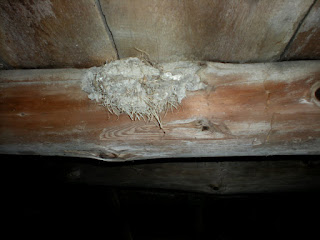What: Last week I spotted a female robin (
Turdus migratorius) bouncing around in the slippery elm (
Ulmus rubra) at the corner of my house. It was so neat to watch because the bird almost had an architectural eye when looking at the tree. I imagined it looking at angles of branches, sturdiness of limbs, relative hiddenness of the entryway access to food and water. She investigated for quite awhile, bouncing every so often to a new vantage point to reassess the quality of her new domicile. I had followed her to the spot because I heard a male robin singing and I hadn't heard one in a while. When I went to investigate I saw the female in my driveway picking up nesting material and then dropping it (female robins alone build the nest and incubate the eggs). It was like she was doing a full inspection of the territory for quality of supplies and location. This week I checked in again on her progress and she is now sitting on some eggs (not sure how many yet, will report back later).
 |
Robins nest made mostly of mud with
twigs, grass, and bark strips (Ruby Mtns, Nevada) |
Ecological notes: Last year a pair nested on the light outside our neighbor's door, the year prior they nested on the floodlight on my garage and fledged three young. I was bummed this year when we didn't have any nesting robins for most of the spring. What a treat though to have this pair, and so late in the year too. Most birds are done nesting by now and have started flocking together in larger groups (Monday I spotted about 50 geese honking and flying towards the lake).

Robins can have two to three clutches in a year, so I'm assuming that this is the second or third for this female this year. In general male robins are a darker gray, with a darker patch of slate on top of their heads, females tend to be browner. Lots of sources I read just parrot other sources, so I don't know how reliable they are. Apparently males have more robust streaks on their throats than females, but I don't know how reliable this is since it's a relative comparison. I'm in out of town right now (the photos are a couple days old), but when I get back I'm excited to look closer at their throats. Since the females are the only ones that sit on the eggs, that should be a pretty easy thing to study. The one sitting on the Males are definitely the only ones that sing though.
Where: My backyard
Other notes: Robins are one of three types of birds we have
that use mud to build their nests, phoebes and swallows being the other
two in Vermont. I've watched a robin dip a stick in mud and carry it to
the nesting site. You can see in the above photo that the nest also
incorporates twigs, grass, and strips of plastic. Phoebe and barn swallows are pictured below:
 |
| Phoebe nest made primarily of moss, (Shelburne Farms) |
| Barn swallow nest made mostly of mud and grass (Bread and Butter Farm) |

 Robins can have two to three clutches in a year, so I'm assuming that this is the second or third for this female this year. In general male robins are a darker gray, with a darker patch of slate on top of their heads, females tend to be browner. Lots of sources I read just parrot other sources, so I don't know how reliable they are. Apparently males have more robust streaks on their throats than females, but I don't know how reliable this is since it's a relative comparison. I'm in out of town right now (the photos are a couple days old), but when I get back I'm excited to look closer at their throats. Since the females are the only ones that sit on the eggs, that should be a pretty easy thing to study. The one sitting on the Males are definitely the only ones that sing though.
Robins can have two to three clutches in a year, so I'm assuming that this is the second or third for this female this year. In general male robins are a darker gray, with a darker patch of slate on top of their heads, females tend to be browner. Lots of sources I read just parrot other sources, so I don't know how reliable they are. Apparently males have more robust streaks on their throats than females, but I don't know how reliable this is since it's a relative comparison. I'm in out of town right now (the photos are a couple days old), but when I get back I'm excited to look closer at their throats. Since the females are the only ones that sit on the eggs, that should be a pretty easy thing to study. The one sitting on the Males are definitely the only ones that sing though.



No comments:
Post a Comment